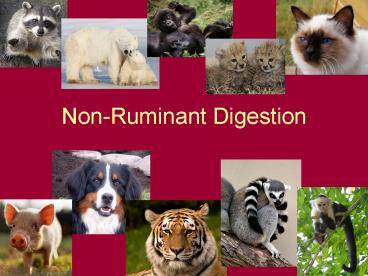Non-Ruminant Digestion - PowerPoint PPT Presentation
1 / 31
Title:
Non-Ruminant Digestion
Description:
Non-Ruminant Digestion * What are Non-Ruminants? Animals with digestive systems that have a simple stomach structure, also called a monogastric system Most animals ... – PowerPoint PPT presentation
Number of Views:637
Avg rating:3.0/5.0
Title: Non-Ruminant Digestion
1
Non-Ruminant Digestion
2
What are Non-Ruminants?
- Animals with digestive systems that have a simple
stomach structure, also called a monogastric
system - Most animals are classified as omnivores or
carnivores
3
The Non-Ruminant System
Mouth
Esophagus
Stomach
Small Intestine
Large Intestine
Anus
4
The Non-Ruminant System
- Mouth
- Collects and chews feed and vegetation
- Teeth
- Carnivores
- Sharp teeth for tearing and ripping
- Omnivores
- Sharp teeth and flat molars for tearing and
grinding
5
The Non-Ruminant System
- Salivary Glands
- Secretes digestive enzymes
- Provide lubrication for swallowing
6
The Non-Ruminant System
- Esophagus
- Connects mouth to stomach
- Unidirectional
- Forceful regurgitation may occur in some animals
when sick
7
The Non-Ruminant System
- Stomach
- Glandular pouch that mixes and churns feed
- Secretes gastric juices and enzymes to aid in
food particle breakdown
8
The Non-Ruminant System
- Pancreas
- Produces and secretes enzymes
- Aids in the digestion of carbohydrates and fats
- Liver
- Lobed reddish brown organ
- Produces bile (greenish in color)
- Aids in the digestion of fats
- Gall Bladder
- Storage sac for bile from liver
- Secretes bile into small intestine
9
The Non-Ruminant System
- Small Intestine
- Secretes intestinal juices
- Pale watery substance from the intestinal wall
- Protein digestion
- Buffers hydrochloric acid from the stomach
- Digests and absorbs nutrients
10
The Non-Ruminant System
- Small Intestine Sections
- Duodenum
- Secretion of intestinal juices, pancreatic
enzymes and bile to further digest food - Jejunum
- Digestion
- Absorption of nutrients
- Ileum
- Absorption of nutrients
11
The Non-Ruminant System
- Cecum
- Non-functioning blind pouch found in-between the
small intestine and large intestine - Large Intestine
- Absorbs water and adds mucus to undigested feed
12
The Non-Ruminant System
- Rectum
- Internal sphincter which controls excretion
- Anus
- External sphincter which controls excretion
13
The Non-Ruminant System
Large Intestine
Small Intestine
Pancreas
Anus
Stomach
Salivary Glands
Mouth
Rectum
Gall Bladder
Esophagus
Cecum
Liver
14
Lobed reddish brown organ, produces bile
(greenish in color), aids in the digestion of fats
15
Secretes intestinal juicesdigests and absorbs
nutrients
16
Secretes digestive enzymes provides lubrication
for swallowing
17
Secretion of intestinal juices, pancreatic
enzymes and bile to further digest food, 1st
section of small intestine
18
Connects mouth to stomachunidirectional
19
Glandular pouch that mixes and churns feed,
secretes gastric juices and enzymes
20
Collects and chews feed and vegetation
21
Produces and secretes enzymes, aids in the
digestion of carbohydrates and fats
22
Who has sharp teeth for tearing and ripping?
23
Absorbs water and adds mucus to undigested feed
24
Storage sac for bile from liver, secretes bile
into small intestine
25
Who has sharp teeth and flat molars for tearing
and grinding?
26
Internal sphincter which controls excretion
27
Absorption of nutrients3rd section of small
intestine
28
Non-functioning blind pouch found in-between the
small intestine and large intestine
29
External sphincter which controls excretion
30
Digestion and absorption of nutrients2nd
section of small intestine
31
The Non-Ruminant System































